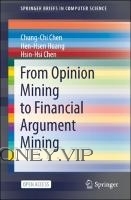
Chapter 1
Introduction
Financial opinion mining is a branch of traditional opinion mining and sentiment
analysis which shares the basic notions of traditional approaches and adds its own
domain-specific characteristics. In Sect. 1.1, we start with a common definition of
general opinion mining after which we briefly overview traditional research direc-
tions. In Sect. 1.2, we compare financial opinion mining and general opinion mining,
and in Sect. 1.3, we explain the motivation behind capturing financial opinions. We
conclude the chapter with an overview of the structure of this book in Sect. 1.4.
1.1 Opinion Mining and Sentiment Analysis
Life is a series of choices, each of which is informed by personal opinions. A person’s
opinion may influence the opinions of others, and in turn influence the decisions they
make. Thus a better understanding of people’s opinions would make it possible for
us to predict behaviors and guess a person’s next steps. For example, every four
years, we attempt to predict the outcome of the US presidential election. If we
were able to capture every voter’s opinion, we would be able to accurately predict
the election results. However, thus ascertaining all opinions before an election is
a difficult problem. We hence must use approximate approaches such as surveys
to identify trends. After 2000, with the development of the Web and the increase in
information shared by users, researchers began to investigate opinion miningmethods
to collect information that was once unattainable. In a common definition, an opinion
is represented as a quintuple
in which an opinion holder h holds an opinion about entity e at time t with sentiments
under aspect a. Based on this definition, opinion mining is also termed sentiment
analysis.
Although these five components, in particular aspect and sentiment, have been
discussed for nearly two decades now, they remain the focus of much active
research due to the wide variety of potential applications. Figure 1.1 shows
an example of an opinion, in this case a product review from Amazon. To simply
judge the overall sentiment of the review writer, we can treat the five-star rating as
a label indicating that the opinion holder possesses a positive sentiment toward the
PlayStation 5 Console. Upon further investigation of the review’s contents, we find
that the opinion holder possesses a positive sentiment toward the new controller but a
negative sentiment toward the bold design and plastic stand. Components e, h, and t,
in turn, are relatively easy to extract from the platform metadata, which explains why
the focus of most research remains on aspect-based sentiment analysis. The example
in Fig. 1.1 shows that the sentiment s can vary depending on which aspect of the
product (i.e., entity e) is in question. Potential task settings include the following:
1. Two-class classification (positive/negative)
2. Three-class classification (positive/neutral/negative)
3. Classification with discrete degrees (one-star to five-star)
4. Regression with continuous sentiment scores (0 to 1 or −1 to 1)
After extracting the opinion components, the problem becomes how to evaluate the
usefulness and helpfulness of the opinion to readers. Figure 1.2 shows a review with
little information. As with humans when making decisions, this kind of opinion may
not be useful. The figure also shows a common approach for evaluating the opinion
for a product: the “Helpful” button allows readers to annotate the review from a
helpfulness aspect. These labels are then used for training supervised models.
Note however that false information or opinion spam also exists on online platforms.
From Opinion Mining to Financial Argument Mining by Chung-Chi




